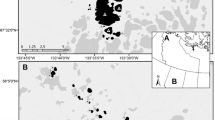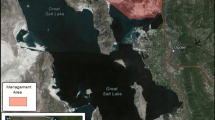Abstract
The abundance and distribution of lesser scaup (Aythya affinis) may be influenced by the availability of amphipod crustaceans, since these invertebrates represent an important food source, particularly for immature birds. Another important factor may be degradation of habitat, since seaup nest in wetland margins and adjacent upland habitats. The objective of this study was to evaluate the relative importance of amphipods, wetland features such as area and water depth, and indices of margin/upland habitat, on the distribution and abundance of scaup. A subsample of 108 oligosaline wetlands was chosen on twelve sites located in three eco-regions of southern Saskatchewan, Canada. Data were gathered during 1995 on relative amphipod abundance, wetland area, fall water depth, upland nesting habitat type, wetland margin impacts, and spring numbers of lesser scaup. Scaup use of wetlands was significantly affected by the availability of amphipods, wetland margin impacts, and wetland area. Controlling for the effect of area showed that scaup were most common on ponds with abundant amphipods and minimal margin impacts. In the southernmost mixed grassland eco-region, scaup were affected by amphipod availability only, whereas in the moist mixed grassland and parkland eco-regions, results indicated that both margin impact and amphipod availability were significant factors. Results are consistent with hypotheses that decreases in scaup numbers since the mid-1980s may be due to (1) loss, resulting from both human and climatic factors, of natural wetlands capable of supporting rich amphipod populations and (2) continuing agricultural encroachment on remaining wetlands.
Similar content being viewed by others
Literature Cited
Afton, A. D. 1984. Influence of age and time on reproductive performance of female lesser scaup. Auk 101:255–265.
Afton, A. D. and C. D. Ankney. 1991. Nutrient-reserve dynamics of breeding lesser scaup: a test of competing hypotheses. Condor 93:89–97.
Afton, A. D. and R. H. Hier. 1991. Diets of lesser scaup breeding in Manitoba. Journal of Field Ornithology 62:325–334.
Afton, A. D, R. H. Hier, and S. L. Paulus. 1991. Lesser scaup diets during migration and winter in the Mississippi flyway. Canadian Journal of Zoology 69:328–333.
Austin, J. E. 1983. Postbreeding ecology of female lesser scaup. M.S. Thesis, University of Missouri, Columbia, MO, USA.
Austin, J. E., C. M. Custer, and A. D. Afton. 1998. Lesser scaup (Aythya affinis). p. 1–32.In A. Poole and FE Gill (eds.) The Birds of North America, No. 338. The Birds of North America. Inc. Philadelphia, PA, USA.
Bartonek, J. C. and J. J. Hickey. 1969. Food habits of canvasbacks, redheads and lesser scaup in Manitoba. Condor 71:280–290.
Bartonek, J. C. and H. W. Murdy. 1970. Summer foods of lesser scaup in subarctic taiga. Arctic 23:35–44.
Batt, B. D. J., M. G. Anderson, C. D. Anderson, and F. D. Caswell. 1989. The use of prairie potholes by North American ducks. p. 204–227.In A. van der Valk (ed.) Northern Prairie Wetlands. Iowa State University Press, Ames, IA, USA.
Creighton, J. H., R. D. Sayler, J. E. Tabor, and M. J. Monda. 1997. Effects of wetland excavation on avian communities in eastern Washington. Wetlands 17:216–227.
de Szalay, F. A. and V. H. Resh. 1997. Responses of wetland invertebrates and plants important in waterfowl diets to burning and mowing of emergent vegetation. Wetlands 17:149–156.
Didiuk, A. B., F. D. Caswell, and G. Hochbaum. 1989. A preliminary manual for habitat assessment procedures during spring air/ground waterfowl surveys in prairie Canada. Canadian Wildlife Service, Winnipeg, MB, Canada.
Dieter, C. D. 1991. Water turbidity in tilled and untilled prairie wetlands. Journal of Freshwater Ecology 6:185–189.
Dirschl, H. J. 1969. Foods of lesser scaup and blue-winged teal in the Saskatchewan River delta. Journal of Wildlife Management 33:77–87.
Dubovsky, J. A., C. T. Moore, J. P. Bladen, G. W. Smith, and P. D. Keywood. 1997. Trends in duck breeding populations, 1955–97. U. S. Fish and Wildlife Report. Migratory Bird Management, Laurel, MD, USA.
Green, R. H. 1979. Sampling Design and Statistical Methods for Environmental Biologists. John Wiley and Sons. New York, NY, USA.
Hammell, G. S. 1973. The ecology of lesser scaup (Aythya affinis Eyton) in southwestern Manitoba. M.S. Thesis. University of Guelph, Guelph, ON, Canada.
Hines, J. E. 1977. Nesting and brood ecology of lesser scaup at Waterhen Marsh. Saskatchewan. Canadian Field-Naturalist 91:248–255.
Holsinger, J. R. 1976. The freshwater amphipod crustaceans (Gammaridae) of North America. U.S. Environmental Protection Agency, Office of Research and Development, Cincinnati, OH, USA. ELD04/72.
Hantrud, H. A. and R. E. Stewart. 1977. Use of natural basin wetlands by breeding waterfowl in North Dakota. Journal of Wildlife Management 41:243–253.
Larson, D. L. 1995. Effects of climate on numbers of northern prairie wetlands. Climate Change 30:169–180.
Leonard, R. A. 1988. Herbicides in surface waters. p. 45–87.In R. Grover (ed.) Environmental Chemistry of Herbicides Volume 1. CRC Press, Boca Raton, FL, USA.
Lindeman, D. H. and W. T. Momot. 1983. Production of the amphipodHyalella azteca (Saussure) in a northern Ontario lake. Canadian Journal of Zoology 61:2054–2059.
Millar, J. B. 1986. Estimates of habitat distribution in the settled portions of the prairie provinces in 1982. Canadian Wildlife Service unpublished report, Saskatoon, SK, Canada.
Millar, J. B. 1989. Baseline (1985) habitat estimates for the settled portions of the prairie provinces Report no. 3: Saskatchewan parkland. Canadian Wildlife Service unpublished report, Saskatoon. SK, Canada.
Millar, J. B. 1992. Baseline (1985) habitat estimates for the settled portions of the prairie provinces Report no. 8: Saskatchewan mixed grass prairie. Canadian Wildlife Service unpublished report. Saskatoon, SK, Canada.
Muck, J. A. and R. M. Newman. 1992. The distribution of amphipods in southeastern Minnesota and their relation to water quality and land use. Journal of the Iowa Academy of Science 99:34–39.
Padbury, G. A. and D. F. Acton. 1994. Ecoregions of Saskatchewan. Map scale at 1∶2000000. Minister of Supply and Services Canada and Saskatchewan Property Management Corporation, Regina, SK, Canada.
Pennak, R. W. and W. N. Rosine. 1976. Distribution and ecology of Amphipoda (Crustacea) in Colorado. American Midland Naturalist 96:324–331.
Pickard, D. P. and A. C. Benke. 1996. Production dynamics ofHyalella azteca (Amphipoda) among different habitats in a small wetland in the southeastern USA. Journal of the North American Benthological Society 15:537–550.
Rice, W. R. 1989. Analyzing tables of statistical tests. Evolution 43:223–225.
Rogers, J. P. and L. J. Korschgen. 1966. Foods of lesser scaups on breeding, migration, and wintering areas. Journal of Wildlife Management 30:258–264.
SAS Institute Inc. 1990. SAS/STAT User’s Guide, Version 6. Fourth Edition, Volume 2. SAS Institute Inc., Cary, NC. USA.
Sheehan, P. J., A. Baril, P. Mineau, D. K. Smith, A. Harfenist, and W. K. Marshall. 1987. The impact of pesticides on the ecology of prairie nesting ducks. Canadian Wildlife Service, Ottawa, ON, Canada. Technical Report Series No. 19.
Smith, A. G. 1971. Ecological factors affecting waterfowl production in the Alberta parklands. U. S. Department of the Interior, Fish and Wildlife Service, Washington, DC, USA. Resource Publication 98.
Smith, A. R. 1996. Atlas of Saskatchewan Birds. Saskatchewan Natural History Society, Regina, SK, Canada. Special Publication No. 22.
SPSS Inc. 1993. SPSS for Windows: Advanced Statistics, Release 6.0. SPSS Inc., Chicago, IL, USA.
Sugden, L. G. 1973. Feeding ecology of pintail, gadwall, american widgeon and lesser scaup ducklings in southern Alberta. Canadian Wildlife Service, Ottawa, ON, Canada. Report Series Number 24.
Toft, C. A., D. L. Trauger, and H. W. Murdy. 1982. Tests for species interactions: breeding phenology and habitat use in subarctic ducks. The American Naturalist 120:586–613.
Turner, B. C., G. S. Hochbaum, F. D. Caswell, and D. J. Neiman. 1987. Agricultural impacts on wetland habitats on the Canadian prairies, 1981–85. Transactions of the North American Conference on Wildlife and Natural Resources 52:206–215.
U. S. Fish and Wildlife Service and Canadian Wildlife Service. 1987. Standard operating procedures for aerial waterfowl breeding ground population and habitat surveys in North America. U.S. Fish and Wildlife Service unpublished report, Laurel, MD, USA.
Wen, Y. H. 1992. Life history and production ofHyalella azteco (Crustacea: Amphipoda) in a hypereutrophic prairie pond in southern Alberta. Canadian Journal of Zoology 70:1417–1424.
Wetzel, R. G. 1983. Limnology. 2nd ed. Saunders College Publishing, Fort Worth, TX, USA.
Author information
Authors and Affiliations
Rights and permissions
About this article
Cite this article
Lindeman, D.H., Clark, R.G. Amphipods, land-use impacts, and lesser scaup (Aythya affinis) distribution in Saskatchewan wetlands. Wetlands 19, 627–638 (1999). https://doi.org/10.1007/BF03161700
Received:
Revised:
Accepted:
Issue Date:
DOI: https://doi.org/10.1007/BF03161700




